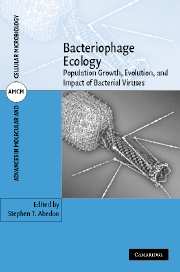Book contents
- Frontmatter
- Contents
- About the cover
- List of contributors
- Foreword by Bruce R. Levin
- Preface
- 1 Phages, ecology, evolution
- Part I Phage ecology
- Part II Phage evolutionary biology
- Part III Phage ecology in environments
- 10 Aquatic phage ecology
- 11 Phage ecology of terrestrial environments
- 12 Phages, bacteria, and food
- 13 Interaction of bacteriophages with animals
- 14 Phage ecology of bacterial pathogenesis
- Part IV Modeling phage ecology
- Index
- Plate section
14 - Phage ecology of bacterial pathogenesis
from Part III - Phage ecology in environments
Published online by Cambridge University Press: 29 September 2009
- Frontmatter
- Contents
- About the cover
- List of contributors
- Foreword by Bruce R. Levin
- Preface
- 1 Phages, ecology, evolution
- Part I Phage ecology
- Part II Phage evolutionary biology
- Part III Phage ecology in environments
- 10 Aquatic phage ecology
- 11 Phage ecology of terrestrial environments
- 12 Phages, bacteria, and food
- 13 Interaction of bacteriophages with animals
- 14 Phage ecology of bacterial pathogenesis
- Part IV Modeling phage ecology
- Index
- Plate section
Summary
INTRODUCTION
Found in Clostridium botulinum, Corynebacterium diphtheriae, Escherichia coli, Pseudomonas aeruginosa, Staphylococcus aureus, Streptococcus pyogenes, Vibrio cholerae, etc., prophage-encoded bacterial virulence factors (øVFs) provide an additional level of interaction between phages, bacteria, and environments (Langley et al., 2003; Brüssow et al., 2004;øVF, which stands for phage-encoded virulence factor, we pronounce “phee-vee-eff.”). In some cases multiple prophages are present in the same cell and each may encode a separate virulence factor (VF). For example, some strains of enteropathogenic E. coli encode several variants of the VF, Shiga toxin, and in a number of Salmonella strains about 5% of the genome consists of prophages, most of which contain VF genes. Despite their unambiguous genomic association with prophages, a question still under debate is whether these VF genes should be considered phage genes or bacterial genes. Supporting the concept that they are simply unusually located bacterial genes, in some bacterial strains the prophage is clearly defective and no progeny phage will ever be produced. On the other hand, there are some VFs that cannot be released from the bacterial cell except following prophage induction, implying a great deal of phage involvement in VF expression. In this chapter we consider the evolutionary ecology and ecological impact — on phages, bacteria, and animals — of phage encoding of bacterial VF genes, especially prophage-encoded exotoxins.
- Type
- Chapter
- Information
- Bacteriophage EcologyPopulation Growth, Evolution, and Impact of Bacterial Viruses, pp. 353 - 386Publisher: Cambridge University PressPrint publication year: 2008
- 8
- Cited by



